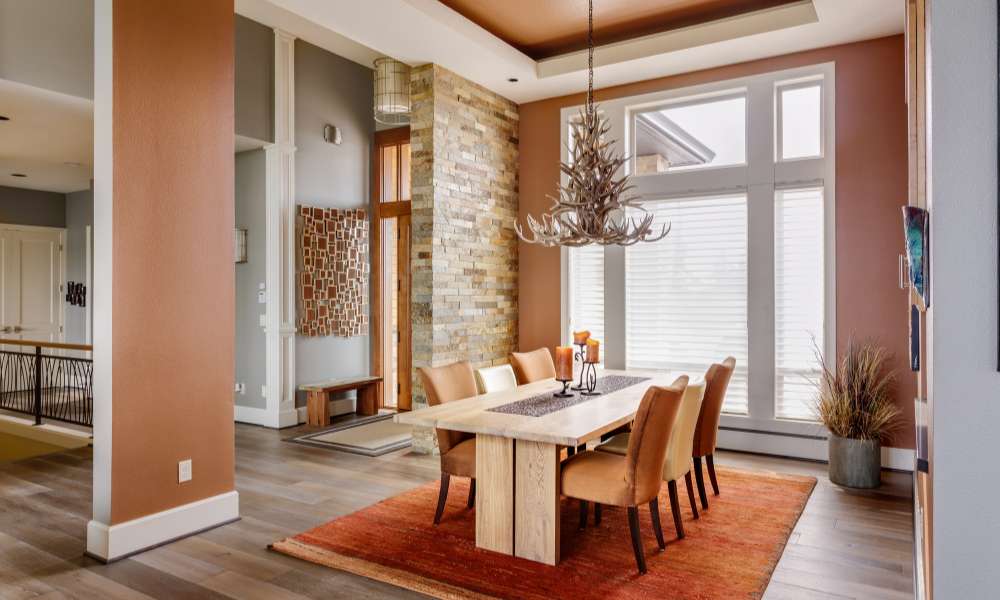Selecting the right size rug for your dining table is more than just a matter of taste; it’s a crucial decision that impacts both the functionality and aesthetic appeal of your dining space. The right rug can define the area, provide comfort underfoot, and protect your floor from scratches and spills. However, the wrong size can disrupt the balance of your room, making it feel cramped or disjointed. In this guide, we’ll explore how to choose the perfect rug size for your dining table, ensuring it complements your space while enhancing the overall dining experience. Whether you have a cozy breakfast nook or a grand dining hall, understanding the principles of proportion, balance, and style will help you make an informed choice that ties the room together beautifully.
1. Understanding the Basics
When choosing a rug for your dining area, it’s essential to start with the basics. An area rug is a piece of carpeting that covers a specific part of a room, distinguishing it from wall-to-wall carpeting. The dining table is the focal point of your dining space, around which meals are shared and memories made. Room dimensions refer to the length and width of the room, which determine how much space you have to work with. The general rule for selecting the right rug size is that it should extend at least 24 inches beyond the table on all sides. This ensures that the chairs remain on the carpet, even when pulled out. Keeping these principles in mind will help you choose a rug that enhances your eating area’s functionality and style.
2. Standard Dining Table Sizes and Rug Dimensions
Dining tables come in various sizes, typically categorized by the number of seats they accommodate. A 4-seater table, usually around 36 to 44 inches wide, pairs well with a 6×9 foot rug. For a 6-seater, which measures approximately 60 to 72 inches, an 8×10-foot rug is ideal. Larger 8-seater tables, stretching 78 to 96 inches in length, require a more substantial 9×12 foot rug. The right carpet size complements the table and ensures it fits proportionally within the surrounding space, creating a balanced look. This proportionality is crucial as it helps define the eating area without overwhelming or underwhelming the overall room aesthetics. Selecting the correct rug dimensions enhances your dining space’s function and harmony.
3. Measuring Your Dining Area
Accurately measuring your dining area is crucial for selecting the perfect rug. Start by measuring the length and width of your eating table. Then, add at least 48 inches to each measurement; this extension ensures that chairs can be pulled out comfortably without catching on the edge of the carpet. For example, if your table measures 60 inches long by 36 inches wide, your minimum carpet dimensions should be 108 inches by 84 inches. Additionally, consider the overall room aesthetics and the space’s traffic flow. Ensure the carpet complements the room without obstructing pathways or doorways. By carefully measuring and accounting for these elements, you can choose a rug that enhances your dining area’s functionality and style.
4. Shape Matters
The shape of your dining table should guide your choice of rug shape to create a harmonious eating space. A round table, for example, pairs best with a round carpet, which enhances the table’s curvature and promotes an intimate dining setting. Similarly, a rectangular table looks most balanced atop a rectangular carpet, which mirrors its straight lines and elongated form. Aligning the carpet shape with the table not only boosts the aesthetic coherence of the room but also maximizes the functionality of the space. This alignment helps define the v area more clearly, making the environment more inviting and organized. Additionally, matching the rug and table shapes can make the eating area appear more spacious and thoughtfully arranged, contributing to a pleasant and cohesive home decor.
5. Material and Style Considerations
Choosing the right material and style for your dining area rug is essential for both durability and design. Wool rugs are a popular choice due to their natural resistance to stains and their ability to recover from indentations caused by furniture. Synthetic fibers like polypropylene or nylon offer practical benefits, being easy to clean and less susceptible to damage from spills, making them ideal for high-traffic eating areas. When selecting a carpet style, consider the overall decor of your dining room. A traditional pattern complements classic furniture and decor, while a modern, minimalist carpet might suit a contemporary space better. The key is to select a rug that not only stands up to the practical demands of eating but also harmonizes with your room’s aesthetic, creating a cohesive look that enhances your home’s character.
6. Placement and Maintenance
Proper placement and maintenance of your dining area rug are crucial for extending its lifespan and keeping it looking fresh. Ensure the carpet is centered under the eating table with equal space on all sides, allowing for the chairs to sit comfortably on the carpet even when pulled out. This positioning prevents uneven wear and tear and maintains balance in the room’s layout. For maintenance, regular vacuuming is essential to remove crumbs and dust particles that can accumulate in the carpet fibers. Immediate attention to spills with appropriate cleaning solutions will help prevent stains. For wool rugs, consider professional cleaning every couple of years to preserve their natural texture and color. Adopting these care practices will keep your rug in prime condition, making it a lasting component of your dining space aesthetics.
Conclusion
Choosing the right rug for your dining table involves careful consideration of size, shape, material, and style. By understanding these elements, you can select a carpet that not only fits your functional needs but also complements the aesthetic of your eating space. A well-chosen carpet will anchor the eating area, enhance comfort, and protect your flooring, all while adding a touch of elegance and warmth. Remember, the key is to balance practicality with style—ensuring that your carpet serves as a harmonious element that ties the room together. Whether you are updating your current dining space or decorating a new one, keep these tips in mind to create a welcoming and beautifully appointed eating environment.





